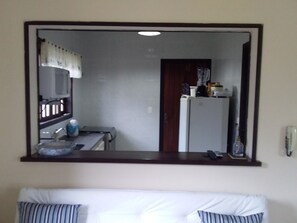Caravan Refugio
Comfortable house ideal for families seeking quiet days to rest and stroll around the region. It has 58sqm with 2 bedrooms, 1 bathroom and kitchen equipped with fridge and stove and household items, living room with sofa and TV (open tv) and table for meals, small balcony with chairs and table to enjoy the outdoors and the garden.
Located in a privileged neighborhood 1.2 km from the Mother Church and close to supermarkets, restaurants, pharmacies and bars.
Cananéia History, Culture and Tourism
Founded on August 12, 1531 by Martim Afonso de Souza, Cananeia is the first city in Brazil. The history of this municipality through which the imaginary line of the Treaty of Tordesillas that divided the world between Portugal and Spain passed, is filled with many legends of pirates, buried treasures and battles.
From this time, there are still some relics such as the church of St. John the Baptist, founded in 1577. Built with wide walls and no windows, it served as a stronghold to protect the city from constant threats of invasion. Other preserved buildings are the obelisk, two cannons and the bronze rings that were embedded in stones and used to tie the caravels of the expedition of Martim Afonso de Souza.
In addition to being a cultural historical heritage, Cananéia stands out for its natural beauty. Listed by the United Nations Educational, Scientific and Cultural Organization (UNESCO) as a natural heritage of humanity and named by the American magazine “Condé Nast Traveler” as the best ecological itinerary in the world, the municipality is formed by several islands, such as Cardoso, Good Shelter, Pup, Cambriú, Castilho, Fig, Bark and Pai do Mato. The best lookout of the islands is Morro São João. According to a local legend, there is an enchanted sea mermaid that appears at the tip of the hill south of the village.
In addition to the islands, the beaches attract thousands of tourists. It is difficult to say which is the most beautiful: Pereirinha, Itacuruçá, Ipanema, Cambriú, Bom Haven (Lighthouse), Marujá, Small Bellows, Bellows, Lages, Whale Cove, Pontal do Leste and so on. Another very visited place is the Ilha do Cardoso State Park (PEIC) Nucleus Perequê, with museum, laboratory and aquarium; hiking trails, hills, coastlines, waterfalls, rivers, lagoons, natural pools, caiçaras communities, lighthouse - there is also the landmark of the Treaty of Tordesillas. The biggest attraction, however, are the porpoises that usually accompany the boats and delight the tourists with their heels. You will also be enchanted by Dolphin Bay, which lies between Ilha Comprida, Ilha do Cardoso and Cananeia. Take a boat trip so you can see them up close.
Cananeia also offers other itineraries and sights that can and should be visited. If you like a good waterfall bath, the city offers many options, but you must have good fitness and adventure spirit. If you take the road that connects the Itapitangui neighborhoods to Ariri, you will find three waterfalls: Pitu, Mandira and Rio das Ostras. Access is by ferry. You must access these places accompanied by an environmental monitor that knows the region and the paths of the waterfalls.
In Cananeia, you can still visit numerous archaeological sites, the sambaquis, dating from six to four thousand years. Sambaquis are mounds of shells that have been accumulated for many years, not by nature, but by ancient locals; probably nomadic group.
If you are fascinated by the water world, visit the Municipal Museum. The second largest shark in the world, which weighed 3.5 tonnes and was caught south of the coast by local fishermen, is on display. "
Quoted text from the saopaulo site. sp. gov. br





